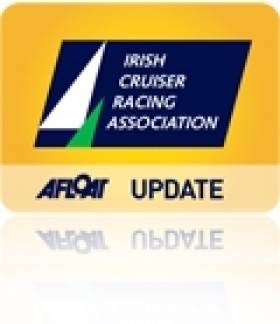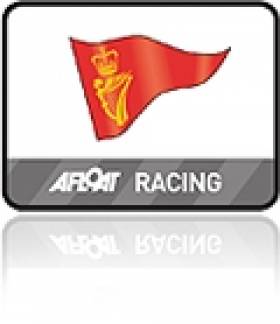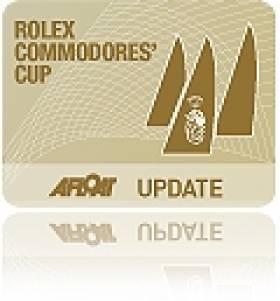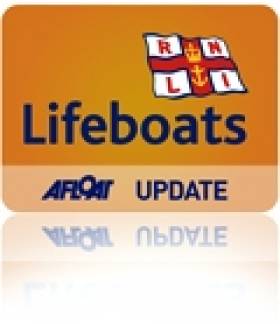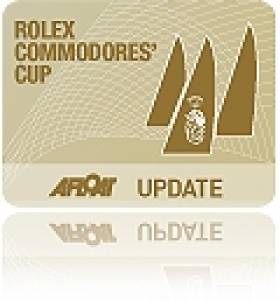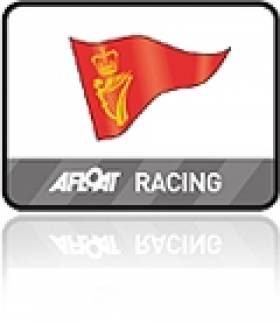Displaying items by tag: Crosshaven
Marinerscove Takes Narrow Lead in 'Boat of the Year' Opinion Poll
Marinerscove leads Afloat's sailing Boat of the Year opinion poll that has attracted over 1700 votes to date. After 20 days of voting the lead has changed several times in the fun poll and early leader Erisslanan, who shared boat of the week with Mariners at Cork week is now in third place on 227 votes, some distance behind ISORA winner Raging bull on 607 votes. 81 votes clear ahead is the Crosshaven boat that also bagged the British IRC title this year. Dave Dwyer's Marinerscove was of course also the middle boat in the victorious Irish Commodores Cup team in August. The ICRA boat of the year award will be awarded on November 13th at the Cruiser Racer conference in Carrigaline. You can vote by using the poll on the left hand side of Afloat's home page.
Latest Photos From Royal Cork's October League
Bob Bateman's latest photos from yesterday's Royal Cork's October League are over the fold. Having sailed six races in the O'Flynn Exhams Autumn League and, with a discard applied, a trend is emerging writes Claire Bateman. The exception to this is White Sail 1 and 2 who have had four races and at the wish of the classes have reverted to two races each day. It was another light day with yachts waiting patiently for the breeze to fill and when it did it was a light breeze from the west going further into the south as the day went on. Richard Leonard's Green Fleet were on a laid course outside the harbour and having postponed the first race during the start sequence, he eventually got the fleet going when the west breeze settled. Class Three and White Sail 1 were started together followed by Class Four and White Sail 2. The mixing of classes made for interesting racing as it kept the boats in close proximity to one another and a second race was sailed successfully thereafter.
On David O'Brien's harbour course with the Red Fleet the breeze was slower to fill in. However, when it did Class 2 and the 1720s were sent on a course to Ringabella against the flood tide. The Class Zero and Class One fleets were over eager and suffered a general recall so they started last. Again they were over anxious and were bunched at the pin end of the line but after some manoeuvering a clear start was called and they too set off for Ringabella, the boats heading for the western shore to avoid the tide faring best. First to reach Ringabella was Jump Juice but she obviously didn't feel like leaving as she clung to the mark having to suffer the fate of watching many of the class rounding before she eventually got free. In Class One IRC Donal O'Leary's D-Tox is on 7 points but David Scott's EOS is on 20 points with Michael Wallace just one point adrift on Felix.
The position in Class Three IRC appears to be the most obvious with the prowling Kenefick/O'Brien Tiger leading with five first places followed by Ian Traver's Bandit on 9 points and in Class Zero IRC the same equally obvious situation pertains with Kieran Twomey's Gloves Off on 5 points and Conor Phelan's Jump Juice on 9 points. In Class Four IRC Mike Sexton's Granny Knot and Alan Mulcahy's Sundancer are tied on 7 points each.
This league is also counting for the SCORA 2010 League as is the April league from Kinsale a total of fifteen races overall with three discards so this also adding spice and competition to the event.
To-day's day prizes were presented by Eamonn Muldoon of O'Flynn Exham's and racing will continue next Sunday with first gun at 10.55 am.
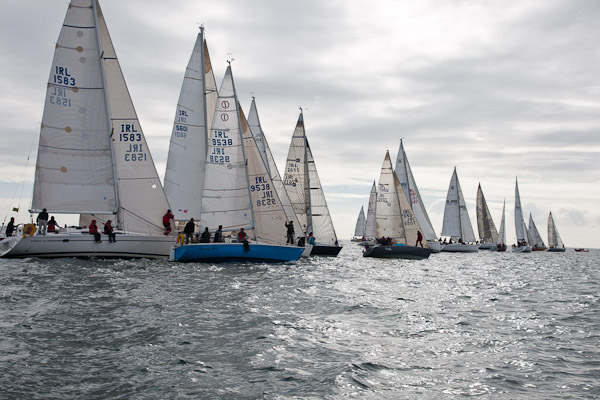
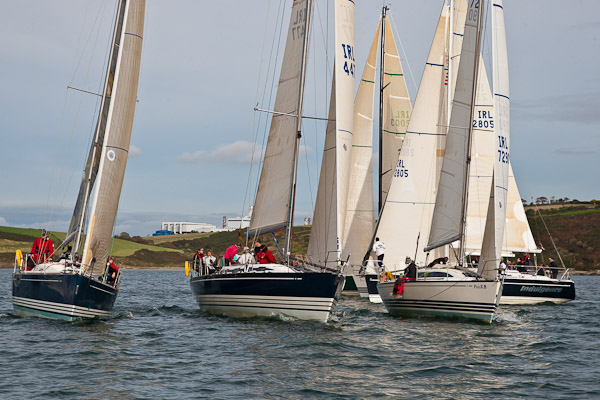


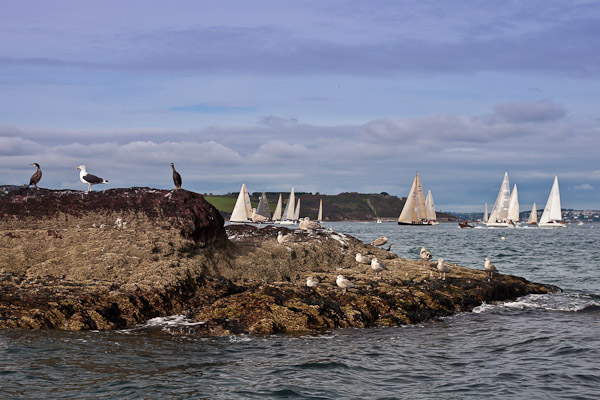


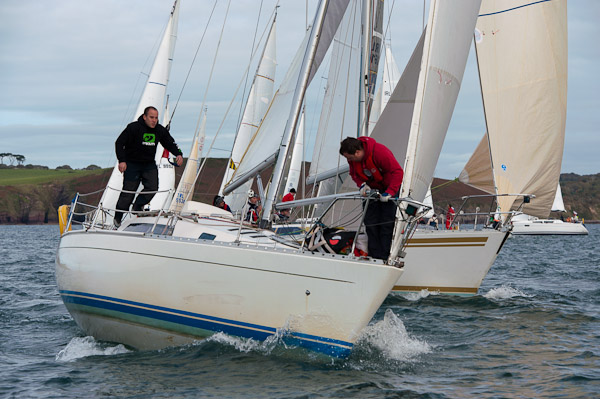

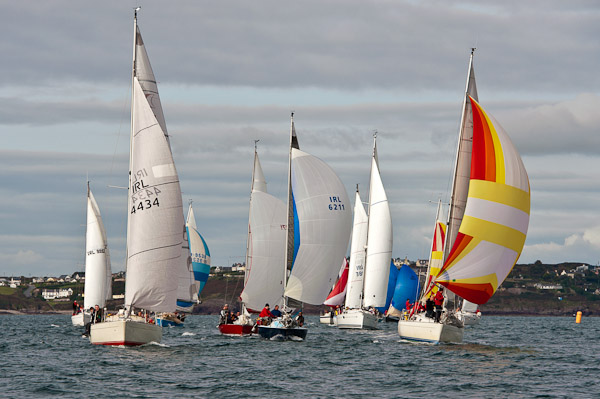


Commodores' Cup Celebration Dinner to be Held at Royal Cork
Team Ireland boats, Antix - Anthony O Leary, Marinerscove.ie - Dave Dwyer and Roxy 6 - Rob Davies and Andrew Creighton, will be represented on the night.
The dinner cost will be €30 and booking will be on first come/first served basis. Book with [email protected] or call 021 4831023.
Crotty Stays on Top in 1720s
The sun may have been missing from the scene this morning at Crosshaven and the skies may have been dark and overcast but the wind was blowing, the buzz was very definitly in the the air and the spring was in every sailors'step as they arrived in their droves to set forth on the second day of the O'Flynn Exhams Autumn League at the Royal Cork Yacht Club writes Claire Bateman. Photos from race two on the gallery click HERE
The wind was gusting some 26 knots on the marina but by the time the boats had reached the comittee boats for the start of racing the east wind had moderated to some 10/12 knots and later went north easterly, was obviously going to provide a good day of sailing. The two Race Officers had put their minds together on the courses and decided to sail both fleets within the harbour and this proved to be an outstanding success. Race Officer David O'Brien was today on Classes Three, Four and Whitesail one and two and his boat "Sabrone" was kindly provided by Admiral Paddy McGlade who was on board for the racing. Richard Leonard's committee boat "Capta Ventum" was kindly provided by Pat Healy who was also on board to watch the day's events unfold.

Tight handling in the second day of Cork's Autumn League races. Photo: Bob Bateman. More on the gallery HERE
There are exceptionally high spring tides at the moment and this exercised the minds of the all sailors to keep out of the strong tide and on the other hand to avoid going aground on any of the banks around the harbour. In this regard the one casualty was Peter Webster's Thistle from Class Four which went aground and spent some time waiting for the incoming tide.
The tight courses and the racing tide coupled with the sufficient breeze made for close racing. John Crotty was a very happy man sailing the 1720 Two 2 Tango and winning the class for the second week in a row. Class One is of course a very competitive class and there was close racing between the 4 X332s. In Class Two it was good to see Bad Company and wicked so close together but the day in Class Two belonged to Shane Statham of Waterford Harbour in Slack Alice who ended first overall in IRC and ECHO. In Whitesail 2 Clive Doherty had an excellent day winning IRC1 and Ernie Dillon received a tumultous reception when his name was called out in the same class for wining ECHO.
The combination of the fleets racing in the magnificent harbour today added greatly to the buzz with yachts flying everywhere and the fleets moving around with the greatest of ease. Some were up off Cobh while others went to a laid mark off the Aghada shore and Whitesaill one and two were given a course which should have taken in the OFE2 buoy outside the harbour but given the fear would lighten even further race officer David O'Brien decided to shorten the course so the white sail fleets hada somewhat easy day of sailing and returned early to the warmth of the club house. It was certainly a huge success on the part of the race officers and added greatly to the enjoyment as was heard from the sailors in their apés sail get totether. There were three protests from the racing today but one was withdrawn and the other two were resolved amicably so all was well and the prize giving presided over by Aeibhín Cahalan of O'Flynn Exhams brought a fitting finish to the day.
Five Incidents in Four Days for Cork Harbour Lifeboat
Crosshaven Volunteer RNLI Lifeboat has had a very busy few days as they were tasked to five incidents in four days.
On Thursday evening at 17.59, the Lifeboat was tasked to the upper reaches of Cork Harbour near the city to check out an unidentifiable object in the water. On arrival, the object was found to be a large bag containing foam. Friday evening, saw the Lifeboat heading up the Owenabue River to rescue two punts which had been floated off on the very high Spring tides and were perceived a danger to shipping.
Saturday evening at 20.34, the Lifeboat was again tasked to the North side of Great Island where a 55' Motor Launch with 3 persons on board had mechanical difficulties and drifting in high winds of force 7. On arrival at scene, the crew decided that because of the size and weight of the vessel and the high winds it was safer to anchor the vessel and take off the crew. They were safely landed at East Ferry Pier. As the Lifeboat was returning to Crosshaven, The Coastguard at Valentia again tasked the Lifeboat to search the area between Cobh and Monkstown for an overdue Rigid Inflatable Boat (RIB). After searching for a period, and with nothing found, the Coastguard stood down the volunteer Lifeboat crew to return to station.
Sunday afternoon, and the pagers were again activated at 16.33 to go to the aid of a small boat with engine problems at East Ferry. On arrival in the area, it was noticed that the casualty boat had managed to restart and head into East Ferry Marina.
Related Safety posts
RNLI Lifeboats in Ireland
Safety News
Rescue News from RNLI Lifeboats in Ireland
Coast Guard News from Ireland
Water Safety News from Ireland
Marine Casualty Investigation Board News
Marine Warnings
Cork Harbour Fort Attracts Thousands of Visitors
Thousands of people from all over Ireland visited Fort Camden, Crosshaven during September when the fort, officially named as Fort Meagher, was open to the public for the first time.
The partnership project, which is being spearheaded by Crosshaven Tourism on behalf of the local community association, is being undertaken by Fas workers with funding from Cork County Council and the active support of Rescue Camden, local businesses and other volunteers the local community
At a reception to mark the restoration of two of its barrack rooms, County Manager Martin Riordan congratulated everyone involved. 'This is all about action by a small group with lots of energy and commitment to their own locality. There's lot of talk about what could and should be done but right now we need more bodies like Crosshaven Community Association and Tourism'.

Mr Riordan paid tribute to Fas and praised the staff in the county council who put so much work into the project over many years, including former chief planning officer Brendan Kelleher. He concluded by saying that there had to date, been a tremendous return for a relatively small investment.
Congratulations were also extended by Cllr John A Collins who said it was a landmark day and the start of a bright new beginning for Fort Camden. The fact that on the day he visited during September, he heard so many non-Irish accents confirmed its exciting potential as a military heritage, tourism and arts attraction.
Paul Brierley, chairman of Crosshaven Tourism said the opening of the first two rooms to be restored was a day of celebration. He spoke of the tremendous voluntary ethos and goodwill and believed the project would be 'a template for the county'
He thanked the county manager 'for allowing us a sense of community ownership, his belief in our ability to deliver, his support thus far' and applauded him for 'a shared vision of realizing the tourism potential of Cork Harbour of which there can be no doubt Fort Camden and indeed Crosshaven will have a huge role to play'.
'We have opened the gates to what we feel will be the 'jewel in the crown' of Cork Harbour and Crosshaven, one of the finest remaining classic artillery forts in the world named after one of the most famous men in Ireland, Thomas Francis Meagher', said Paul who urged people to continue supporting the project and visit the website www.rescuecamdenm
Further works are ongoing and it is hoped to again re-open to the public Fort Camden on a temporary basis in March.

Pictured at the reception (from left) Cllr Paula Desmond, County Manager Martin Riordan, Cllr Deirdre Forde, Simon Coveney TD, Deputy Mayor of County Cork Cllr John A Collins and Cllr Seamus McGrath.
1720s Ready for Cork Harbour October Contest
Ten 1720s will contest Sunday's first race of Royal Cork's October league in force. The 2010 league marks the return of these sports boat to Cork Harbour but it comes at the expense of the club's three Commodore's cup boats originally planning to take part.
At least two 1720s are entered by the O'Leary family which almost certainly means the Ker 39 Antix will stay on its berth. Peter O'Flynn from Baltimore is sailing and other 1720 entries have been received from Tom Durcan and Denis Murphy.
Following the successful Commodore's Cup campaign Marinerscove is now in the UK and Andrew Creighton has indicated the small boat Roxy will not be sailing.
There have been a few tweaks to the format of the league and this year there will be two courses both starting with committee boats.
Competitors from other south coast ports such as Waterford Harbour SC arrived in Crosshaven this week.
Course Zero, One and Two and 1720 designated as Red Fleet while classes three, four, Whitesail One and White sail Two will be designated Green Fleet and the classes will alternate between the courses each weekend.
Prizes will be awarded for first, second and third place in each class and a daily prize giving will take place no later then 17.30 hrs in the RCYC Club House. The final prize giving will take place at the prize giving gala dinner on Saturday, October 30th.
Taking Care of Sails this Winter
Mildew
Caused by storing sails wet and dirty, or salty. Remove by soaking for 2 hours in a cold solution of 1 part of bleach (Domestos etc) added to 10 parts of water. Rinse afterwards and repeat as required.
Bloodstains
Caused by overworking crews! Soak in a solution of half cup of ammonia to half gallon of water. Rinse thoroughly
Oil and Grease stains
Small areas can be cleaned with a dry cleaning fluid such as TRI or PERCHLORETHYLENE. For larger areas use a cleaner such as Polyclens. Brush it well into the fabric, leave it for 15 minutes and wash off in lukewarm water. Please note that some grease stains will contain metal or rust particles which are hard to remove. Try 1 oz. oxalic acid in a pint of hot water as a rust remover but do wash the sail and your hands thoroughly afterwards.
Paint and Varnish
Don't use paint stripper – it removes sail and all! Try alcohol (but not the best Jameson's) or Meths. If that isn't potent enough use TRI or PERCHLORETHYLENE, followed by a 50/50 mixture of acetone and amyl acetate. Wash with warm water and detergent to avoid the very un-nautical smells!
Having got the worst stains off your sails, you now come to the washing – and maybe at this stage the thought of ringing us to collect and wash is quite attractive!
Small sails can be washed in the bath and large ones on a clean wash down area, using a scrubbing brush and a hose. Don't use water hotter that comfortable hand temperature. Any brand of liquid detergent can be used.
Very dirty areas can be treated with neat detergent and left overnight before scrubbing off.
Don't leave the sail to soak or dry on corrosive or hot pipes – you might end up with dirtier sails or have odd shapes heat-shrunk into them.
Speaking of odd shapes, this is the perfect time to get your sails re-cut to bring back their original shape, speed and performance.
When you get your sails back from us, store them in a dry place and when the 2011 season comes they will be in the best possible condition to serve you once again.
Sailmakers have various arrangements for the pick, up and delivery of sails. If after reading this advice and you're in need of some professional help, why not consult our advertisers in this feature?
Commodores' Cup Arrives in Ireland
The Rolex Commodores' Cup arrived back in Cork last night and winning team Ireland received a heroes welcome from the Royal Cork Yacht Club writes Claire Bateman.
In his welcome Admiral Paddy McGlade mentioned there were ten trophies for the event, eight of which were won by Team Ireland. One was for best British boat that obviously Ireland couldn't win, and the other was for best female crew category which they certainly couldn't win! When Team Leader Anthony O'Leary arrived he received a standing ovation and was joined by Andrew Creighton and his family.
Unfortunately marinerscove.ie skipper David Dwyer was still on his way home and could not be present but nonetheless marinerscove.ie was very much in the minds of all present.
In the Team Leader's speech Anthony made special mention of and paid tribute to Rob Davies of Roxy 6 and the hugely important part Roxy had played in the successful outcome.
He said Antix and marinerscove.ie had been around for some time but Roxy was a new build recently launched. He again expressed his gratitude for the unstinting and unswerving support so generously provided by Rob Davies any time it was requested for Roxy's campaign.
ICRA Commodore Barry Rose also spoke and gave a graphic description of the final race of the series and how well the Irish team coped with the conditions when all around them other boats were having major difficulties.
The formalities over, the Admiral rang the bell and the team members and their supporters enjoyed refreshments as they relived the seven days of the Rolex Commodores' Cup.
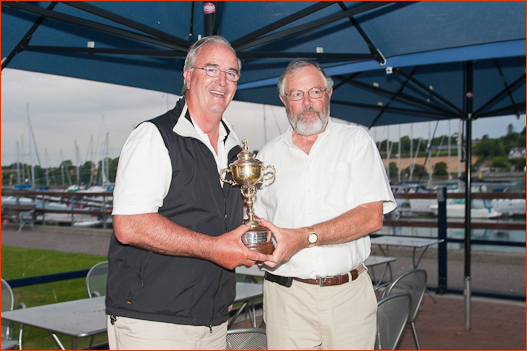
Job well done. Team Ireland Captain Anthony O'Leary is welcomed home by Royal Cork Admiral Paddy McGlade. Photo: Bob Bateman
An tSciocháin, a 1956 Bounty ll, crewed by five volunteers from the Crosshaven Lifeboat and skippered by Pat Fagan was the sole Irish entry in La Coupe des TROIS Phares that departed Crosshaven for France at the weekend.
An tSciocháin is skipperd by Pat Fagan with crew members Brendan Fagan, Pat Harris, Alan Barton and Gus O’Donovan
The competitors crossed the start line at the mouth of the harbour between the committee boat and the E4 mark under National Race Officer, Richard Leonard assisted by RCYC Admiral Paddy McGlade writes Claire Bateman.
The event is a long-range cruising-race the classic yachts from
With a northerly wind and an ebbing tide (PHOTOS BELOW) the sailors were wise in being a little bit shy of the line but with spinnakers hoisted off they went and made a pretty sight as they headed out into the open sea watched by spectator boats including the Crosshaven Inshore Lifeboat. returning from exercise. The fleet was accompanied by their mother ship Notre Dame des Slots and other vessels.
There was a very nice gesture from the competitors as each yacht saluted and thanked the Race Officer as they passed the committee boat.
No doubt many of the boats had stories attaching to them but none more so than the yacht Pen Duick ll formerly owned by the late Éric Tabarly and now in the ownership of the École Nationale de Voile. Monsieur Tabarly, a former French Naval Officer was often known as the father of French sailing.
It has been a very enjoyable week for both the Competitors and the Royal Cork Yacht Club concluding with a dinner in their honour last evening (Fri) complete with traditional Irish entertainment consisting of music and dancing with the French visitors joining in with gusto. The partying went on until the early hours of the morning. Many friends were made and there is expectation they will return again to the Royal Cork Yacht Club in 2012.

Pat Fagan's 'An tSiochain' departs Cork Harbour for France. Photos: Bob Bateman
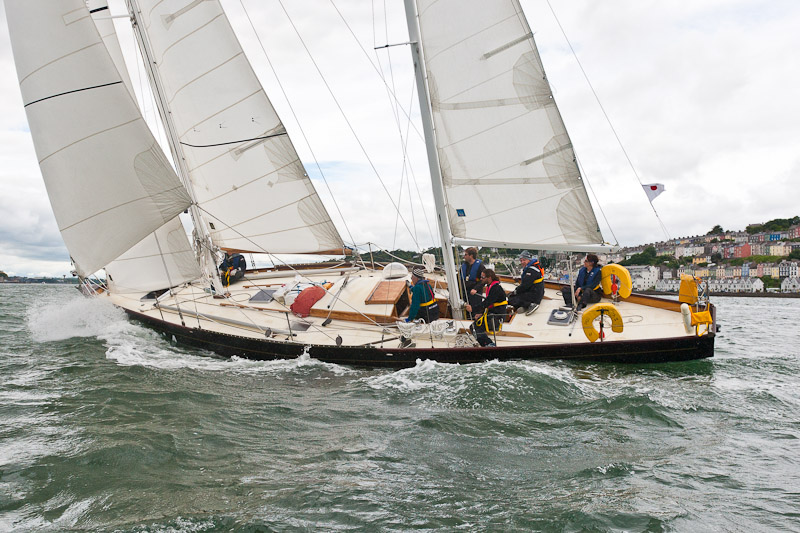

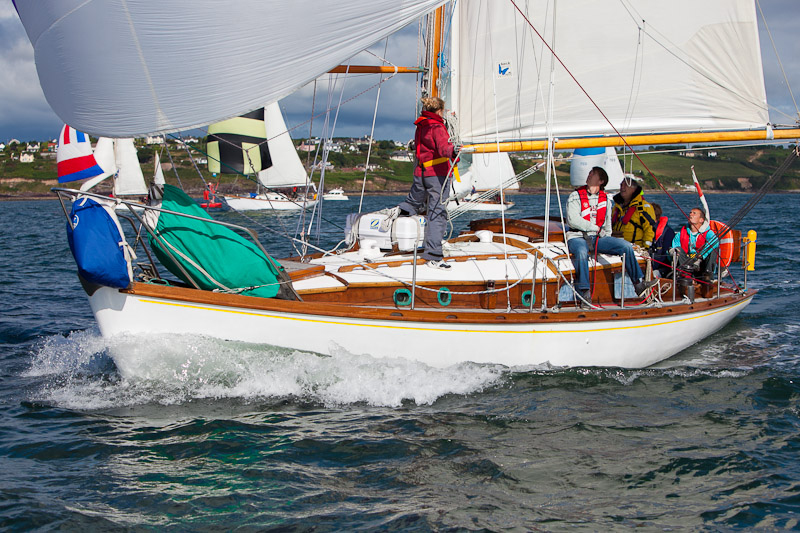
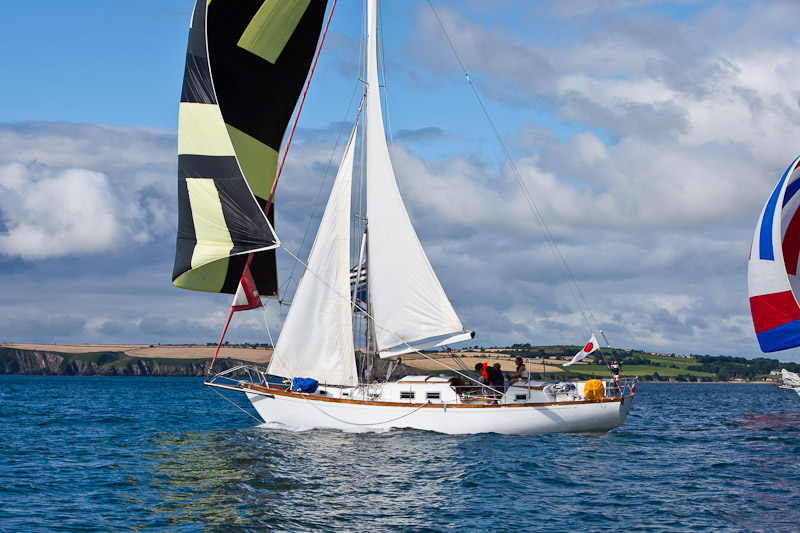



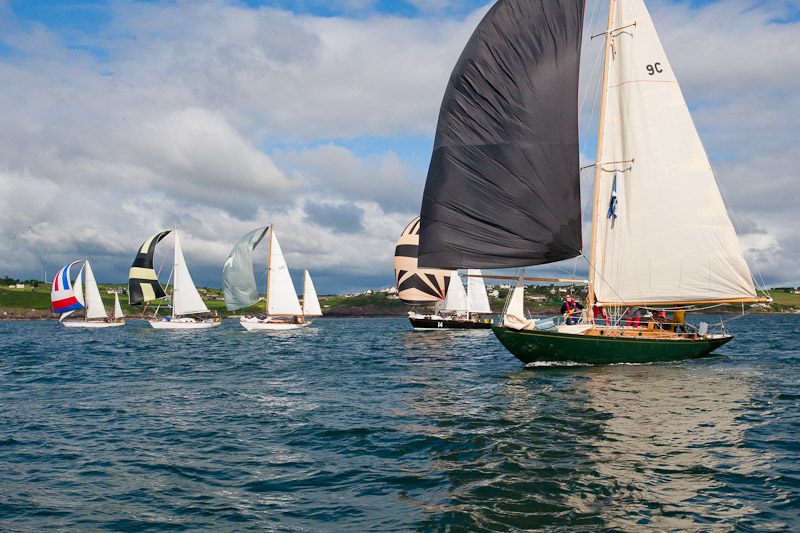
More Photos on the Gallery HERE


























